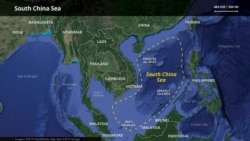Marine life in the politically disputed South China Sea took another hit over the past year, researchers said, due to overfishing and lack of international efforts to protect species.
Vessels from multiple Asian countries are going farther out into the 3.5 million-square-kilometer sea and casting deeper because coastal waters yield increasingly little, scholars and published research indicate. Giant clam harvesting, added to use of cyanide and dynamite bombing for fish, damaged coral reefs last year, the analysts said.
Marine life in the sea that stretches from Taiwan southwest to Singapore comes into focus every May, when China declares a moratorium on fishing above the 12th parallel, which encompasses waters most frequented by China but bisecting both Vietnam and the Philippines. The bans that began in 1995 will last this year from May 1 to August 16.
“We’re all in this pretty rapid decline when it comes to biodiversity in the South China Sea and we certainly don’t see any evidence that anybody is doing anything about it,” said Gregory Poling, director of the Asia Maritime Transparency Initiative under the Washington-based Center for Strategic and International Studies.
Fishing in the sea expanded rapidly in the 1980s and early 1990s, to about 10 million tons per year but then started stagnating, researchers Cui Liang of China’s Xiamen University and Daniel Pauly from the University of British Columbia said in a 2017 paper.
Since then, the study said, boats have fished deeper and caught smaller fish. Still, the South China Sea accounted for 12 percent of the global fish catch just five years ago, according to CSIS. Analysts could not estimate the total 2019 catch volume because of lack of national-level data.
“The coastal areas are already overfished, so that means that fishing fleets from China, Taiwan, Korea, even Japan would actually be swarming now into the center of the South China Sea area, which means there is that concern about overfishing, and then, not to speak of that island-building processes that China conducted,” said Herman Kraft, a political science professor at University of the Philippines Diliman.
Among the problems is continued use by Asian fishing crews of dynamite and cyanide bombing, the conservation group Global Underwater Explorers said on its website. The practice, which wrecks coral reefs and fish spawning zones, is “widespread throughout Asia and the South China Sea, from Indonesia to southern China,” the website said.
CSIS pointed to “large-scale” clam harvesting and dredging for island construction. China has wrecked 40,000 acres of coral reef to build islets for human use, Poling said. Giant clam harvesting last year by Chinese boats hurt coral around Scarborough Shoal west of Luzon Island in the Philippines, media outlets in Manila said.
Military groups in the sea’s Spratly Islands have shot turtles and seabirds, raided nests and fished with explosives, the World Wildlife Fund said on its website. One turtle species, the hawksbill, is endangered.
Brunei, China, Malaysia, the Philippines, Taiwan and Vietnam claim all or part of the sea that is also valuable because of its energy reserves and marine shipping lanes. An estimated 37 million people depend on fishing there for a living, while state-to-state conservation talks are rare.
The declining fishery stocks push each country’s fleet to look harder for what’s left, Poling said. About 4 million Chinese fishing crew members are expected to obey China’s moratorium, but crews from other countries, which contest sovereignty over that tract of sea, are unlikely to change course because they do not recognize the Chinese claim.
Most conservation efforts to date come from individual countries.
About five years ago, academics in the Philippines suggested creating a protected area in the Spratlys, and the idea gained a following in government agencies, although not at the presidential level, Kraft said. Vietnam had proposed nearly 20 years ago that a separate160-square-kilometer tract of the archipelago become a protected area. Both countries control some of the Spratly islets.
Coral in 3,500 square kilometers of open sea around the Taiwan-controlled Pratas islets showed improvement last year because the Taiwanese coast guard has stepped up patrols to keep foreign-registered fishing vessels away, said Chuang Cheng-hsien, a conservation section chief under the Marine National Park Headquarters. China also claims the three Pratas atolls.
Eight or nine years ago, he said, foreign vessels would fish near the protected atolls.
“They get pushed out now, so there’s a big difference in numbers between now and the past,” he said. “In that area there’s virtually no destruction by mechanized fishing boats.”









